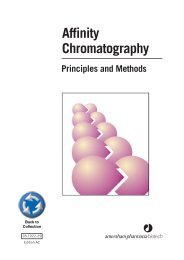Tabletop Rotors and Tubes
Tabletop Rotors and Tubes
Tabletop Rotors and Tubes
Create successful ePaper yourself
Turn your PDF publications into a flip-book with our unique Google optimized e-Paper software.
<strong>Tubes</strong> <strong>and</strong> Accessories<br />
LABWARE MATERIAL COMPATIBILITY WITH SOLVENTS AND SAMPLE<br />
The chemical compatibility of tube materials with the gradientforming<br />
medium or other chemicals in the solution is an important<br />
consideration. Although neutral sucrose <strong>and</strong> salt solutions cause<br />
no problems, alkaline solutions cannot be used in Ultra-Clear or<br />
polycarbonate tubes. Polycarbonate <strong>and</strong> Ultra-Clear tubes are incompatible<br />
with DMSO, sometimes used in the preparation of sucrose<br />
gradients for sedimentation of denatured DNA. Refer to Appendix A<br />
for detailed compatibility information.<br />
GRADIENT FORMATION AND FRACTIONATION<br />
Consideration should be given to gradient formation <strong>and</strong> fractionation<br />
when choosing a tube for a density gradient run. If the b<strong>and</strong>s or zones<br />
formed during centrifugation are indistinct, they may not be visible<br />
through a translucent material such as polyallomer. If optimum b<strong>and</strong><br />
visualization is important, Ultra-Clear, polycarbonate, or cellulose<br />
propionate tubes should be used. Whenever collection of b<strong>and</strong>s or<br />
zones must be done by slicing or puncturing the tube, a thin, flexible<br />
tube wall is required. Ultra-Clear or polyallomer tubes should be used<br />
in these cases, depending on the need for transparency.<br />
LABWARE TYPES<br />
➠ NOTE <strong>Tubes</strong> made of cellulose nitrate were formerly<br />
used for various separations, particularly<br />
rate-zonal separations. Beckman Coulter discontinued<br />
the use of cellulose nitrate for tube<br />
manufacture in 1980, due to inconsistent<br />
physical properties inherent in the material.<br />
If you currently have cellulose nitrate tubes,<br />
dispose of them. Consult your laboratory safety<br />
officer for proper disposal procedures.<br />
<strong>Tabletop</strong> Ultracentrifuge <strong>Rotors</strong> <strong>and</strong> <strong>Tubes</strong><br />
2-3

















